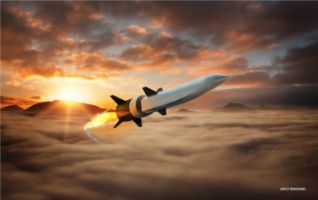Supersonic & Hypersonic Weapons - Global Market & Technology Forecast to 2027 - ResearchAndMarkets.com
The "Global Supersonic and Hypersonic Weapons - Market and Technology Forecast to 2027" report has been added to ResearchAndMarkets.com's offering.
Speed is the new stealth
Speed is the shadow warrior of this century - and major countries around the world have realized it. This is why the United States, Russia, and China are investing aggressively in developing not just supersonic cruise missiles but also hypersonic cruise missiles and hypersonic glide vehicles.
While the U.S., Russia, and China are ahead of other nations in developing hypersonic weapons, countries like France, India, and Australia are also developing military uses of hypersonic technology. Proliferation could cross multiple borders if hypersonic technology is offered on world markets.
Based on rigorous study of the capabilities of supersonic and hypersonic weapons and the growing impact this technology has caused in military environments, the publisher has just launched this new study.
This new report aims to achieve the following objectives:
- Demonstrate the importance of Supersonic & Hypersonic weapons for the military globally
- Relate the concept of interoperability of hypersonic weapons with man & unmanned systems
- Analyze and forecast the market size of the Supersonic & Hypersonic market in the US and globally
This report concentrates on the following types of Supersonic & Hypersonic Weapons:
- Land Attack Cruise Missile
- Air Launched Cruise Missile
- Anti-Ship Cruise Missile
- Hypersonic Glide Vehicle
- Surface to Air Missile
- Tactical Ballistic Missile
- Non-Missile Kinetic Penetrators
Military spending for this technology is expected to grow as an overall percentage of large military budgets such as the United States' defense budget and the Chinese defense budget, offering specialized missile manufacturers and software developers a tremendous opportunity.
Reasons to buy
- Determine prospective investment areas based on a detailed trend analysis of the global Supersonic and Hypersonic weapon industry over the next eight years
- Gain an in-depth understanding of the underlying factors driving demand for different systems segments in the top spending countries across the world and identify the opportunities offered by each of them
- Strengthen your understanding of the market in terms of demand drivers, industry trends, and the latest technological developments, among others
- Identify the major channels that are driving the global Supersonic and Hypersonic weapon business, providing a clear picture about future opportunities that can be tapped, resulting in revenue expansion
- Channelize resources by focusing on the ongoing programs that are being undertaken by the ministries of different countries within the Supersonic and Hypersonic market
- Make correct business decisions based on a thorough analysis of the total competitive landscape of the sector with detailed profiles of the top systems providers around the world which include information about their products, alliances, recent contract wins, and financial analysis
Key Topics Covered
1 Introduction
1.1 Objective
1.2 Market definition
1.3 Methodology
1.4 Events based Forecast Scenario
1.5 Who will benefit from this report
1.5.1 Business Leaders & Business Developers
1.5.2 Defense Primes
1.5.3 Policy Makers, Analysts, and Planners
1.6 Language
2 Executive Summary
2.1 Global Supersonic & Hypersonic Weapons - Classification Based on Type, Guidance System, Technology
2.2 Global Supersonic & Hypersonic Weapons - Trends and Insights
2.3 Major Findings
2.4 Major Conclusions
2.5 Important Tables and Graphs
3 Current & Future Technologies - Global Supersonic & Hypersonic Weapons
3.1 Introduction
3.2 Current Technologies
3.3 Classification Based On Type
3.3.1 Land Attack Cruise Missile
3.3.2 Air Launched Cruise Missile
3.3.3 Anti Ship Cruise Missile
3.3.4 Hypersonic Glide Vehicle
3.3.5 Surface to Air Missile
3.3.6 Tactical Ballistic Missile
3.3.7 Non-Missile Kinetic Penetrators
3.4 Classification Based On Guidance Systems
3.4.1 Infrared Homing
3.4.2 Laser Homing
3.4.3 Radar
3.4.4 Satellite-Based Navigation
3.4.5 Acoustic Homing
3.5 Classification Based On Technologies
3.5.1 Aerodynamics
3.5.2 Propulsion
3.5.3 Structure/Materials
3.5.4 Guidance & Control
3.5.5 Seeker
3.5.6 Munition Design
3.5.7 Satellite Navigation Sensors
3.5.8 Automatic Target Recognition
3.5.9 Data Link
3.5.10 Mission Management
3.5.11 Cost / Logistics
3.5.12 Observables/Survivability
3.6 Chinese & Russian Supersonic and Hypersonic Programs
3.7 Future Technologies
3.8 Countering Supersonic and Hypersonic Weapons
3.8.1 Directed Energy Weapon
3.8.2 Space-Based Sensors
3.8.3 Glide Breaker
4 Current & Future Market Overview - Global Supersonic & Hypersonic Weapons
4.1 Introduction
4.2 Current Markets
4.2.1 North America
4.2.2 Europe
4.2.3 Asia
4.2.4 Middle East
4.2.5 Rest of the World
4.3 Future Markets
4.4 How to reach scale
4.4.1 Challenges Involved In Scaling
4.4.2 Strategy For Scaling
5 Market Analysis
5.1 Introduction
5.1.1 Industry Chain Structure
5.1.2 Support For Local Industry
5.1.3 Policy
5.1.4 Drivers
5.1.5 Inhibitors
5.1.6 Opportunities
5.1.7 Challenges
5.2 Porter's 5 Forces Analysis
5.2.1 Competitive Rivalry
5.2.2 Supplier Power
5.2.3 Buyer Power
5.2.4 Threat of Substitution
5.2.5 Threat of New Entry
5.3 Macro environment
5.3.1 Macroeconomic factors
5.3.2 Political
5.3.3 Economic
5.3.4 Social
5.3.5 Technological
5.4 Forecast factors
6 Forecast - Global Supersonic & Hypersonic Weapons Market by Region to 2027
6.1 Introduction
6.2 Global Supersonic & Hypersonic Weapons market by Regions overview
7 Forecast - Global Supersonic & Hypersonic Weapons Market by Type to 2027
7.1 Introduction
7.2 Global Supersonic & Hypersonic Weapons market by Type overview
7.3 Global Supersonic & Hypersonic Weapons Market by Type - Regional Breakdown
8 Forecast - Global Supersonic & Hypersonic Weapons Market by Guidance System to 2027
8.1 Introduction
8.2 Global Supersonic & Hypersonic Weapons market by Guidance System Overview
8.3 Global Supersonic & Hypersonic Weapons market by Guidance System - Regional Breakdown
9 Forecast - Global Supersonic & Hypersonic Weapons Market by Technology to 2027
9.1 Introduction
9.2 Global Supersonic & Hypersonic Weapons market by Technology Overview
10 Events Forecast - Global Supersonic & Hypersonic Weapons Market to 2027
10.1 Introduction
10.2 Events forecast factors
10.3 Events Forecast by Global Market
10.4 Event Forecast by Type
10.5 Event Forecast by Guidance System
10.6 Event Forecast by Technology
11 Leading Companies in the Global Supersonic & Hypersonic Weapons Market
11.1 Airbus Defence & Space
11.1.1 Company profile
11.1.2 Global Supersonic & Hypersonic Weapons Products & Services
11.1.3 Financial information
11.1.4 Contact
11.2 AeroVironment Inc.
11.3 BAE Systems
11.4 Boeing Co.
11.5 Elbit Systems
11.6 Israel Aerospace Industries (IAI)
11.7 Leonardo
11.8 Lockheed Martin
11.9 Northrop Grumman Corp.
11.10 Saab
11.11 Other Companies of Interest
12 Conclusions & Recommendations
12.1 Major Conclusions and Recommendations
12.2 Fulfilling the business objectives
Companies Mentioned
- AeroVironment Inc.
- Airbus Defense & Space
- Almaz-Antey
- BAE Systems
- Boeing Co.
- Curtiss-Wright Corporation
- Denel SOC Ltd
- Elbit Systems
- General Dynamics Corporation
- Israel Aerospace Industries
- Kongsberg Gruppen ASA
- Leonardo
- Lockheed Martin
- MBDA
- Nexter Group
- Northrop Grumman Corp
- Saab
- Safran Electronics & Defence
- Tactical Missiles Corporation
- Textron Inc.
- Thales Group
For more information about this report visit https://www.researchandmarkets.com/r/lk9c43
View source version on businesswire.com: https://www.businesswire.com/news/home/20190429005284/en/







